

| WARNING Some replacement tires may adversely affect handling and cause an accident resulting in serious injury or death. To ensure proper handling and stability, use only the recommended standard tires for replacement, inflated to the standard pressure. |
NOTICE
Replace the air valve whenever the tire is replaced.
Do not reuse the air valve.
Remove the valve cap, lubricate the stem seal [A] with a soap and water solution or rubber lubricant, and pull [B] the valve stem through the rim from the inside out until it snaps into place.
NOTICE
Do not use engine oil or petroleum distillates to lubricate the stem because they will deteriorate the rubber.
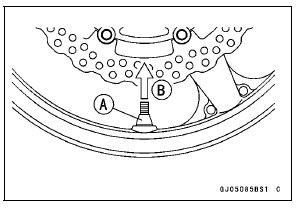
Valve Cap [A] Valve Core [B] Stem Seal [C] Valve Stem [D] Valve Seat [E] Valve Opened [F]
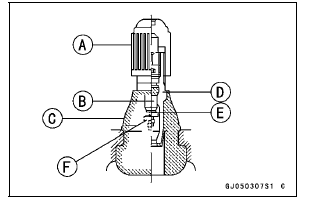
Tire Rotation Mark [A] Rotating Direction [B]
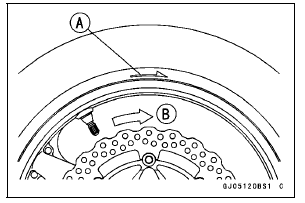
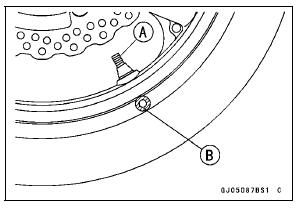
| WARNING Overinflating a tire can cause it to explode, causing serious injury or death. Be sure to install the valve core whenever inflating the tire, and do not inflate the tire to more than 400 kPa (4.0 kgf/cm², 57 psi). |
If the rim flanges and tire sidewall rim lines are not parallel, remove the valve core.
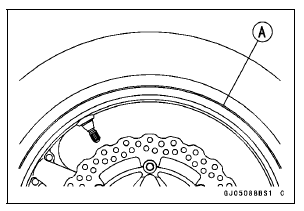
Inflate the tire slightly above standard inflation.
Use a soap and water solution or submerge the tire, and check for bubbles that would indicate leakage.
 Tire Removal
Tire Removal Tire Repair
Tire RepairWheel/Tire Damage Inspection
Remove any imbedded stones [A] or other foreign particles
[B] from tread.
Visually inspect the tire for cracks and cuts, and replace
the tire if necessary. Swelling or high spots indicate internal
damage, requiring tire replacement.
Visually inspect the wheel for cracks, cuts and dents ...
Rear Shock Absorber Scrapping
WARNINGPressurized nitrogen may explode when
heated.
The rear shock contains nitrogen gas. To avoid
an explosion, do not incinerate the shock body
without first releasing the nitrogen and removing
the shraeder valve.
Remove the rear shock absorber (see Rear Shock Ab ...
Clutch Cover Assembly
Replace the needle bearings and oil seal with new ones.
NOTE
Install the needle bearings so that the manufacture’s
mark face out.
Install the needle bearings [A] and oil seal [B] position as
shown in the figure.
Press the upper and lower bearings so that the bearing
surface [ ...